FINANCIAL ADVISOR INSIGHTS: Investors Are Their Own Worst Enemies Advertisement
 FA Insights is a daily newsletter from Business Insider that delivers the top news and commentary for financial advisors Jason Zweig: Investors Are Their Own Worst Enemies (The Wall Street Journal) Jason Zweig of The Wall Street Journal writes that investors who receive constant news updates on their investors have lower returns that those who don't. He also argues that investors are their own worst enemies. "One of the main reasons we are all our worst enemies as investors is that the financial universe is set up to deceive us. From financial history and from my own experience, I long ago concluded that regression to the mean is the most powerful law in financial physics: Periods of above-average performance are inevitably followed by below-average returns, and bad times inevitably set the stage for surprisingly good performance. "But humans perceive reality in short bursts and streaks, making a long-term perspective almost impossible to sustain – and making most people prone to believing that every blip is the beginning of a durable opportunity. "My role, therefore, is to bet on regression to the mean even as most investors, and financial journalists, are betting against it. I try to talk readers out of chasing whatever is hot and, instead, to think about investing in what is not hot. Instead of pandering to investors’ own worst tendencies, I try to push back. My role is also to remind them constantly that knowing what not to do is much more important than what to do. Approximately 99% of the time, the single most important thing investors should do is absolutely nothing." FINRA Reports $10.4 Million Profit In 2012 (Investment News)
The Financial Industry Regulatory Authority (FINRA) reported a profit of $10.5 million in 2012 driven by higher fees, cost cutting, and better returns on its portfolio, according to Investment News. On an operating basis, however, it posted a $89.2 million loss. This was better than the $89.8 million loss in 2011. The Chart That Says The Gold Sell-Off Still Has A Long Way To Go (Credit Suisse) Gold prices fell 23% in Q2 2013. While gold prices were up today, a chart from Credit Suisse that compared the inflation adjusted gold prices during the 70s bull market with gold prices today. A look at this chart says gold prices could tumble further. 
Busting The Myth That Active Strategies Are Better Than Passive Ones (Index Universe) The debate over active and passive management never seems to die down. In a new piece, Larry Swedroe at Index Universe debunks a paper by American Century Investments called Six Reasons to Emphasize Active Investment Management. One reason cited in the paper is that active portfolios can outperform passive portfolios. The paper argues, "Even a simple equity portfolio, such as an equal-weight portfolio, has historically outperformed its market cap-weighted counterparts over various market cycles. The equal weighting captures an important stock price behavior, the mean-reversion." Swedroe however sees three problems with this argument. 1. : "The paper confuses indexing/passive investing with the exclusive use of a total stock market fund or an S&P 500 Index fund." 2. "An equal-weighted portfolio’s outperformance over a market-cap one has nothing at all to do with mean reversion." 3. "If active managers were able to persistently identify in advance which sectors/stocks were going to outperform or revert to mean, we would see evidence of persistent outperformance beyond the randomly expected." S&P 500 Investors Don't Need To Freak Out About An Emerging Market Meltdown (Goldman Sachs) S&P 500 companies have great exposure to international markets. But there have been growing concerns about emerging market growth and investors have been fleeing EMs. But David Kostin at Goldman Sachs says investors needn't worry too much. "We believe weaker EM growth poses little risk to S&P 500 earnings. We estimate roughly 5% of S&P 500 revenues are derived from EM, and BEA data suggest a similar EM share of total US corporate profits. Two-thirds of S&P 500 sales are domestic, making our forecast for stronger US GDP the biggest driver of our EPS growth forecasts of 11% and 8% in 2013 and 2014." 
|
No comments:
Post a Comment